It all started with the destruction of more than fifteen works due to frustration, and I was also haunted by the feeling that they were not good enough. Since I decided to focus on my inner feelings and intuition, I began randomly to grasp possible ideas as I went through my destruction.

I am fascinated by Brian Massumi’s phrase “When I think of my body and ask what it does to earn that name, two things stand out.” It moves. It feels.” Because in fact, it turns out that I only move and feel, I’m not even sure that my brain is turned on when I work. By listening to my body, I realised that my emotions are often triggered by information from social networks and, as a rule, this is negative and annoying information about war and human aggression. When I put these two things together, it became interesting to note that I began to destroy my colour fields after the first year of the war because of the quantity of negative information I received.
So, now of tearing off newspapers from one work, and I feel I should replace the lower strong blue colour with sticks.

This blue felt tough and strong against the airy light yellowish white. Now, when I reflect on this process, I understand that I felt this blue as something enhanced than paper. Here I delve deeper into the synesthetic perception of material and colour, its play and combination.

As a result, my feeling of the heaviness of the boards was supported by the dark colour and the lightness of the newspaper by the light colour.


Overall, this work is one of my many attempts to resist the methods of classical art and show the beauty of the most ordinary materials.
I'll move on to another similar work right away. But I made it much later after the first one.


I wanted to introduce more storytelling and play with forms, and wanted to see how more complex forms would behave in newspapers.

I searched for a composition for a long time, guided by my intuition. And as a result, although I like the gradation of colour and the play of shapes, at the same time, it feels boring.
I want to compare this work with my earlier and stronger composition that works.

Untitled (Fairy tale), 2024, recycled newspapers,canvas, paint, screws, metal grid, cardboard, acrylic, fixatives, wood, 104 x 174 x 15 cm.
I think that due to the overall balance of objects on the surface and only one colour, this work functions and the small one does not.
I also wondered if I would make a colour field using only boards.
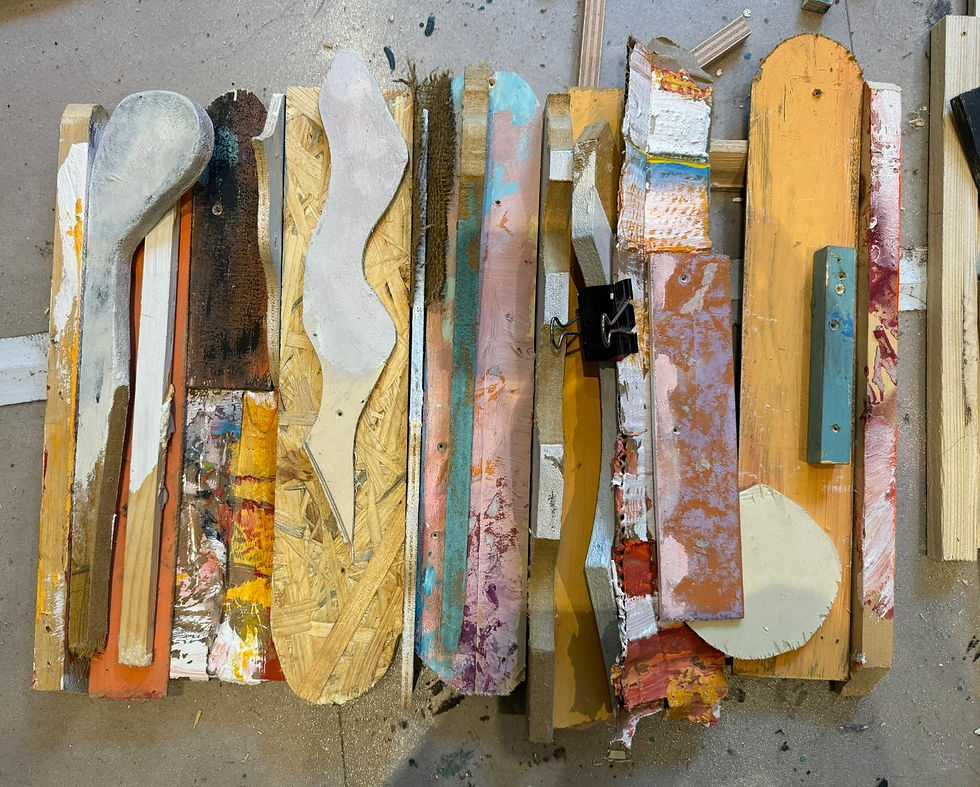
I started with a small size. Here I immediately lack a sense of neatness.


I wanted to put the work in a frame.

I was impressed by my move to completely abandon my newspapers. After all, this is the primary source and reason for my discovery of synesthesia. Giving up newspapers is like cheating on a man. If you love one and are happy in your relationship, why try anything else? Why not go deeper into the relationship and make it more enthusiastic? It is precisely this point, stability and heritage, that Deleuze's theory of "difference" is criticized for. The philosopher views constant change and "becoming" as the driving force of progress and growth. That's what the university asks from me also. But if I have love, why change my happiness?
In any case, with all my thoughts, I liked this process of work, but I have an irresistible desire to see a large size. What will this give me? This unexpected version of the colour field is intriguing and sharply contrasts unnecessary ugly boards with a gentle and poetic colour. What more strongly destroys the stereotypes of the viewer’s perception through such contrast.
In onether work, I abandoned organized storytelling.

Even though audiences react enthusiastically to this work, it doesn't give me the feeling of a "powerful work."
It’s as if I haven’t decided exactly what this work is about and what exactly I want to say.
Here I want to note the value of the fact that, in parallel with my studies, I try to present my works at exhibitions; this gives me incredibly important feedback from the audience.

At the moment I have two important exhibitions going on at the same time.
Important because on one I show my sculptures for the first time,

and second because I won the participation in the International Paper Exhibition at the Museum. This is my first museum!




Further.
Since I started by destroying the work, I ended up with a lot of paper in my studio. Therefore, without hesitation, I started making paper.

It was a long, dirty and not easy process. I had to buy a new mixer and I immediately burned it.
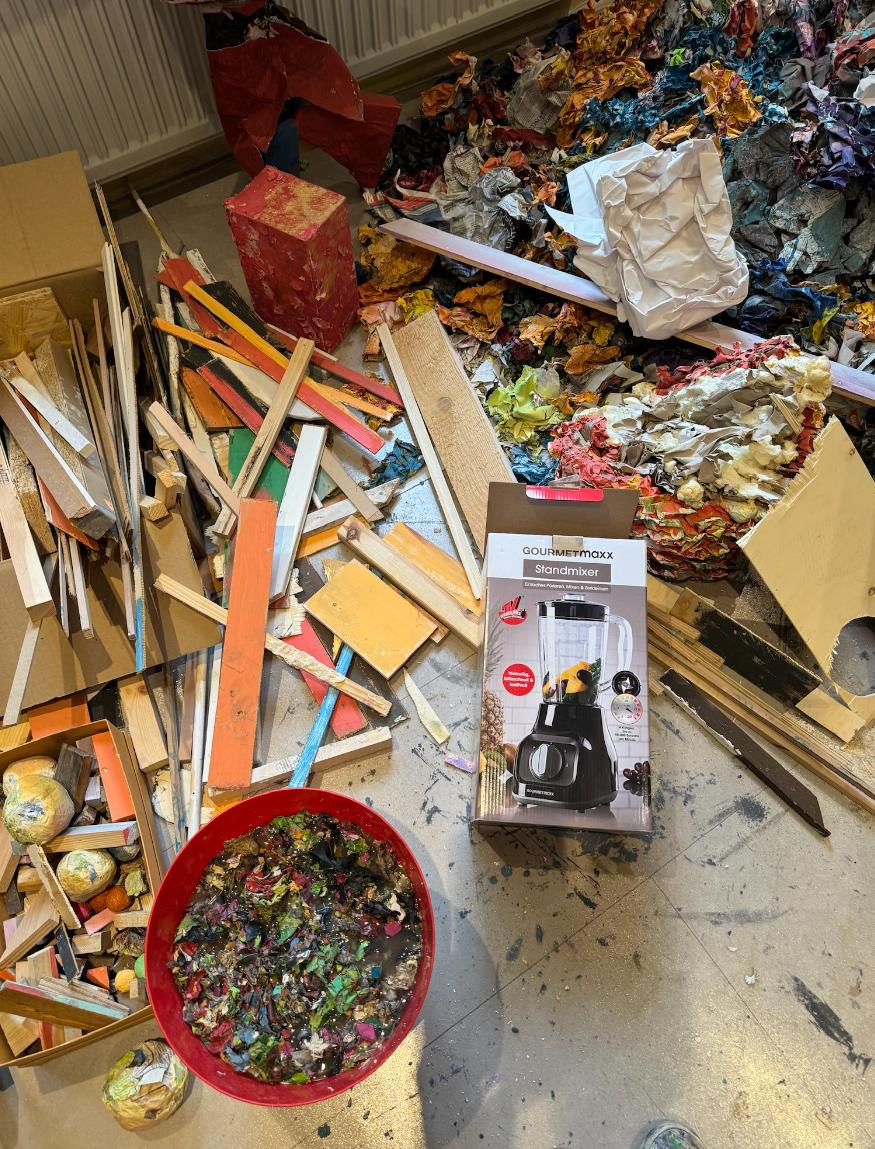
The paper all the time broke and fell apart

and many additional tools had to be made to actually create the paper.



But, I was delighted with the result.

The dried paper turned out to be speaking and pleasant.

Rich in stories due to the remaining paint and pieces of news text.

It would be possible to exhibit such work in a gallery. But I wasn’t impressed; I wanted to work here more. And I have often seen such recycled newspapers, only they came from other stories.
I started writing.

Entering the text back into the newspapers is rhetorical and gives a rich narrative.
The phrases themselves and their formation took a lot of time.

This opens up for me the path of direct expression and communication with the viewer. At the beginning of this experiment, I was delighted, but now, as time passes, I again return to the fact that abstraction is purer in communication with the unconscious. Words speak to the brain, not to the soul, as I would like it. Also, I noticed that no matter how much I formulated the text, I only came up with slogans. And this reminds me of inverted propaganda - anti-propaganda.
Analysing these works, I mentally put myself before a choice, I imagine my wooden sculptures in the air on the left, and these “slogans-appeals” on the right, and intuitively I always choose a sculpture. This was an incredible experiment for me, but for now I'll leave the idea with the text and test other ideas.
I tried to photo-shop and test the transfer of a figurative photo onto this super-textured surface.
I have already used this technique once in 2020 to transfer photographs onto canvas,

and in this case, it should also work. But before I test the data physically, I test it digitally.
The result is sad... I mean sad for me. This is a reality that no longer exists - my parents and sister, happy and together. What other viewers will see in this work is a once (due to colour and transparency) happy family, against the backdrop of a destroyed building. Sadness, grief, melancholy, pain... once the viewer looks at this work, he immediately considers it a direct negative. There is no multi-layered search for interpretations here, everything is said directly and bluntly - it was like this, but now everything is bad.
How can such work help me in my research? First point, if I make a projection onto this paper, and not an application, then I can turn this static work into a video. And I can post the video on social channels that my parents watch. This way I can communicate with them. The second point is that such a personal, figurative narrative can break the complacency of the viewer through the contrast between normal life and war.
In parallel with these processes, I conducted another experiment.
Through social media, I met a professional coating master who works with a lot of famous artists.

I prepared two small works for the test and took them 400 km to him.
According to the master, covering paper with such heavy paint turned out to be difficult and contradictory. As a result, the work has become much stronger, but if it is damaged, it can no longer be repaired.

At the same time, pop art rang in my eyes!
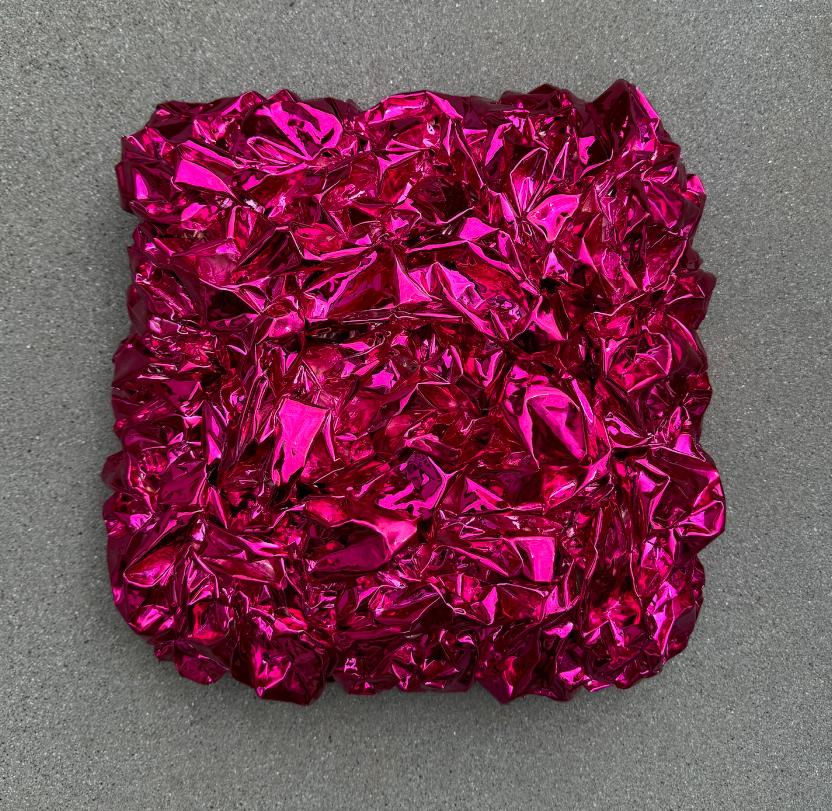
Such a contradictory and very expensive treatment of unnecessary waste challenges perception.

And it adds value to the material and my work with it.

At the moment, I can't figure out where this direction will go, but I really want to try the large format. The question again arises, how can I be sponsored for such an expensive experiment, where I don’t even know whether I will like the result or not?
While I was doing my sculptural sketches,
I tried to integrate a small sculpture,

but the result looks very forced to me and most likely I will redo everything.
Therefore, I will move on to a more successful and productive experiment, but which also cost me a lot of investment.
In one of my current sources of inspiration - social networks, I saw an open call for artists. It was necessary to create a three-dimensional collage with certain small dimensions.
I liked the task and decided to try it.

Through tests and samples, a 25x25 cm intriguing assemblage was obtained.
But the most important discovery happened when I started taking photographs and video documentation for the competition application. (by the way, I didn’t pass; I was rejected).

One photo simply fascinated me.

And then I remembered my tutor’s comment about another photograph of my work. About this:

The photograph of my physical work is a separate independent work and at the same time gives a multi-layered interpretation.
Therefore, I specially photographed one of my works and ordered a photo under acrylic coating.

But as it cost €180 (£155) I was unable to order a larger photo size which would have particularly emphasized the enlargement of the small detail.

Excerpt from my analysis for the Essay:
The decision to photograph a specific detail of my wooden sculpture and make it bigger and put it under plexiglass, positioning it alongside the original sculpture, creates a dialogue between the tangible and the abstract, the macro and the micro. This approach can invite viewers to engage with my artwork on multiple levels, both visually and conceptually.
Firstly, by isolating and enlarging a particular detail of the sculpture, I draw attention to the intricate textures, colours, and forms that might otherwise go unnoticed. This process allows viewers to appreciate the aesthetic qualities of the material itself, highlighting the inherent beauty found in unconventional materials and artistic processes.
At the same time, the act of photographing and enlarging this detail transforms it into a standalone artwork, separate from its original context within the sculpture. This abstraction opens new possibilities for interpretation, encouraging viewers to explore the relationship between the macroscopic and the microscopic, the whole and its individual parts.
In terms of contextualization, this approach underscores the idea of artistic experimentation and innovation, challenging traditional notions of representation and perception. By presenting the enlarged detail alongside the original sculpture, I create a visual dialogue that prompts viewers to question their preconceived notions of scale, materiality, and artistic expression.
Furthermore, the juxtaposition of the photograph and the sculpture speaks to the process of artistic creation itself, emphasizing the importance of observation, exploration, and experimentation in the development of visual art. Through this interplay of image and object, I invite viewers to consider the dynamic relationship between form and content, representation and abstraction, and the tangible and the intangible.
Overall, my decision to magnify and display a specific detail of my wooden sculpture alongside the original artwork adds depth and complexity to my artistic practice, inviting viewers to engage with my work in new and unexpected ways. It serves as a reminder of the boundless possibilities of artistic expression and the transformative power of the creative process.
As a result, I am amazed by the result and the interpretations that have opened up. Now the only question is that photographing and correcting the photograph turned out to be very difficult, and printing was expensive. Let's see how and where I can show these works together with my sculpture works.
To sum up my experiments and work during this course,


I want to note that I have started a project of 6-meter times 2,5 meter temporary installation on the wall - "Temporary Life", which I plan to finish within the next month.
I am also in the process of my first collaboration with another artist, the results of which I will write about later.
Besides this, I again tried to make drawings, but again without results. And I visited several OCA workshops, which turned out to be completely unproductive for me, because for some reason they discussed topics that I had already covered or worked on.
In general, I notice that my experience of exhibitions and constant experimentation with art widens the gap in understanding of the art world with my fellow students. At the same time, I have been invited to several closed groups for OCA students and I use these meetings to get critique my art, which provides me with incredible support.
And most importantly, I made serious and productive progress in my essay writing and identifying the main interests in my work.























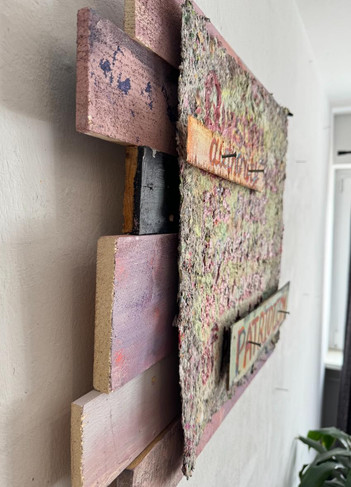











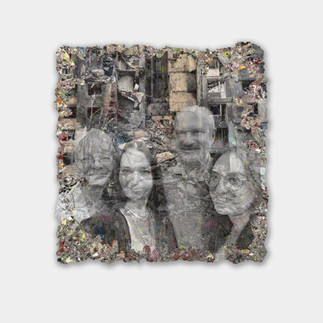






























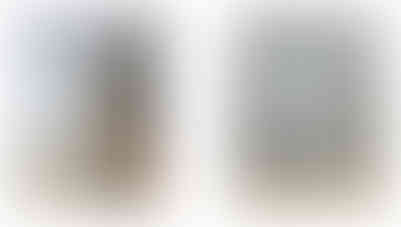





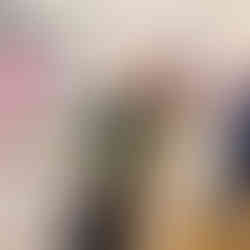




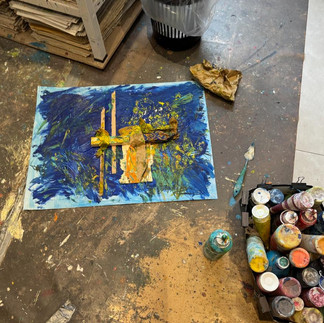


Comentarios